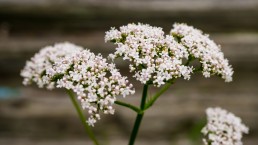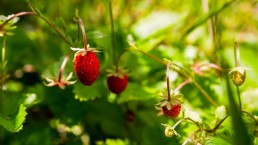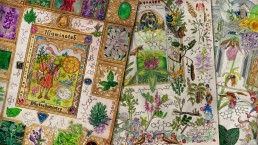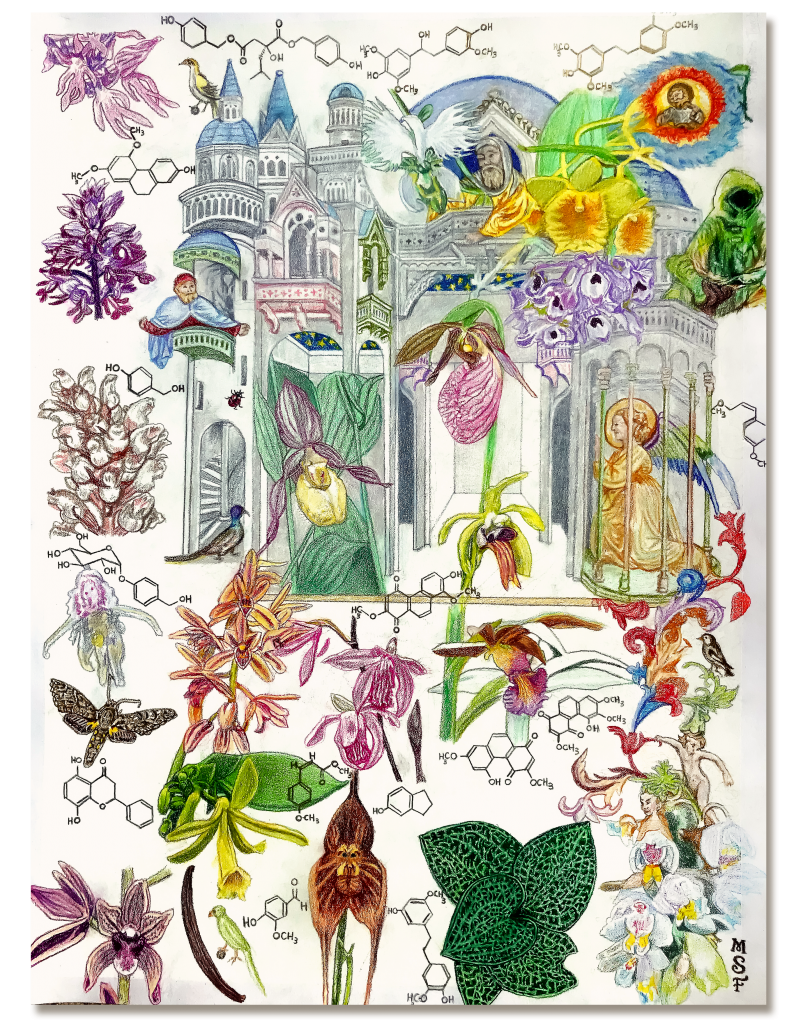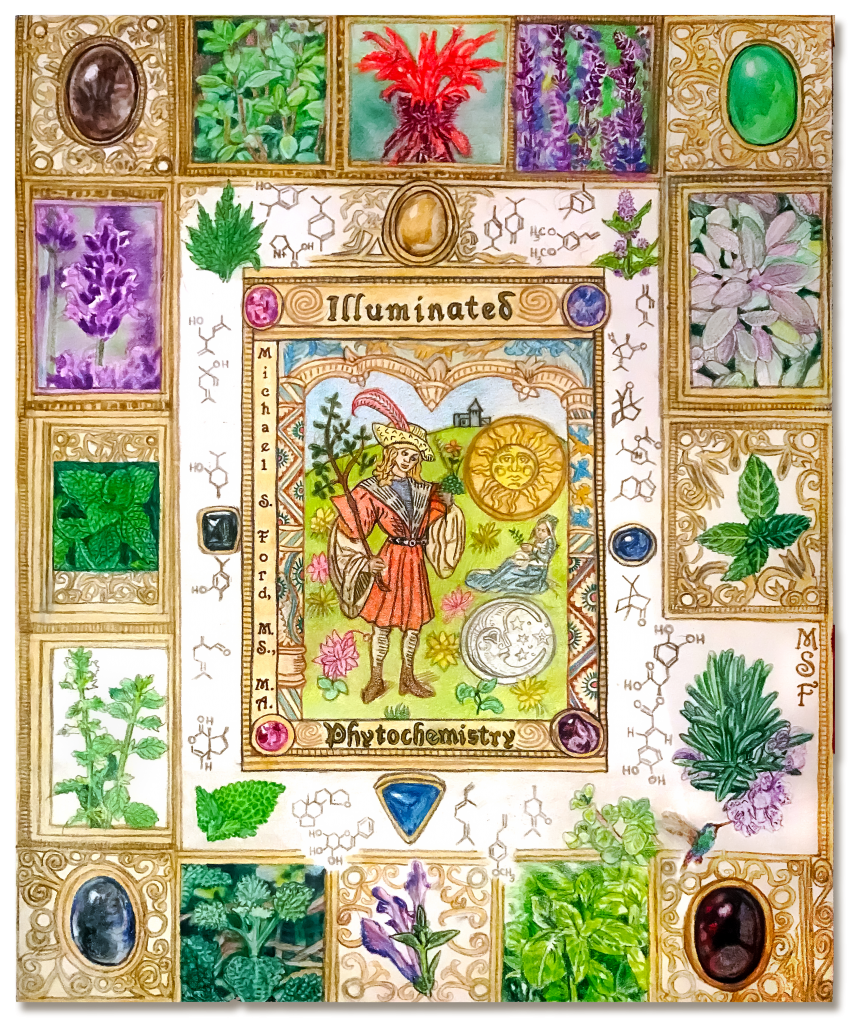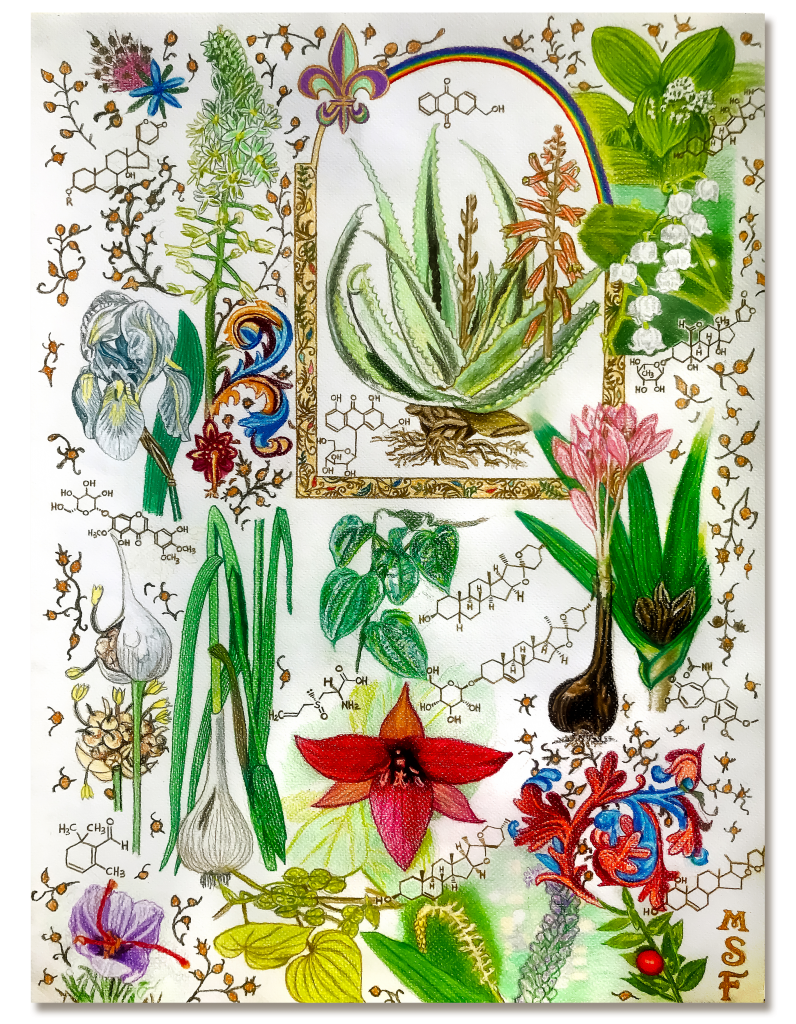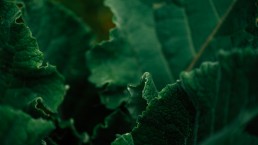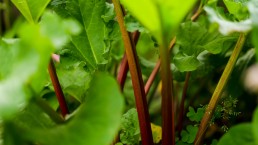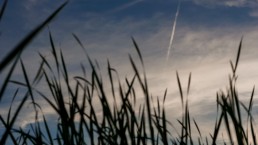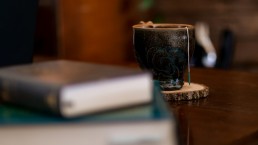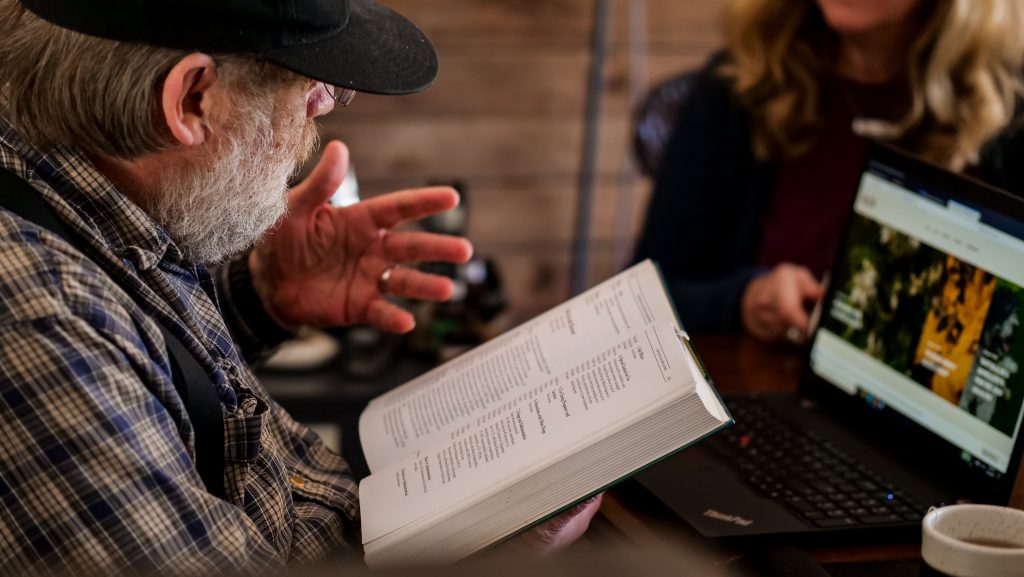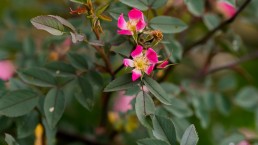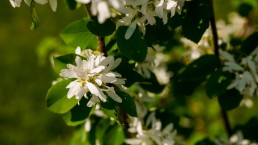Valerian: Materia Medica
Valerian
Botanical name: Valerian officinalis
Pertinent Information on the Plant
-
Nervine (relaxant, sedative)
-
Good for stress and anxiety
-
Great for cardiovascular problems
-
Nervous tachycardia (speeding up of heart rate due to stress, tension and anxiety can be helped)
-
Hypnotic (will induce sleep)
-
Anti-spasmodic (digestive spasms or colic can be relieved)
-
Sedative (calm the nervous system and reduce stress and nervousness throughout the body)
-
Headaches (Stress related, vascular)
-
Anti-depressant
-
Indigestion – due to stress
-
Gastritis – due to stress
-
Colitis – due to stress
-
Analgesics (Pain reliever for muscular, tooth ache, burns, Gall bladder, cuts, wounds, sore throat etc)
-
Dysphagia – problem with swallowing
-
Premenstrual tension
-
Menstrual cramps
-
Insomnia
-
Regulates sleep and restfulness
-
Shingles
-
Psoriasis
-
Menopause – anxiety or depression
-
Reduce sexual drive (sexual energy)
-
Carminative
-
Itching and skin rash (with burdock and Echinacea)
-
Itching from Poison ivy and poison oak
-
Strengthens and tones heart (hypertension and irregular and rapid heartbeat)
-
Herb is non addictive
-
Herb can be used long term
Habitat and Growing area
-
Widespread in damp meadows throughout Europe and is often on banks beside freshwater ponds and streams. I have many growing on our farm in Ontario. Can also be found locally on many roadsides.
Extra Notes
- Some people compare the smell of its flowers to dirty socks!
- A good ingredient in teas, especially bed time blends.
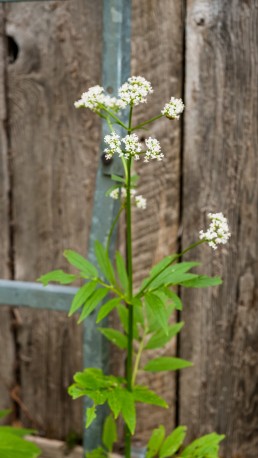
Reference Books:
Holistic Herbal, by David Hoffmann
Pages: 27, 28, 39, 53, 54, 56-60, 62, 65, 70-72, 74, 78, 86, 87, 95, 99, 101, 104, 105, 140, 143-146,159, 186, 194, 108 210, 221, 233, 238, 241
The Way of Herbs, by Michael Tierra
Pages: 12, 20, 26, 32, 34, 36, 202,
The Complete Encyclopedia of Herbs, by Nico Vermeulen
Page: 299
Family Herbal, by Rosemary Gladstar
Pages: 50, 86, 26, 48, 49, 61, 63, 69, 75, 79, 85, 88, 96, 98, 99, 101, 111, 187, 261, 277, 295, 368-70
Peterson Field Guide: Easter/Central Medicinal Plants and Herbs, by Steven Foster and James A. Duke
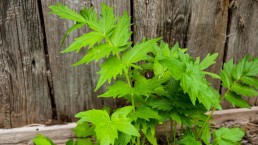
Ode’imin: The Heart Berry
“The Heart Berry”
The warm weather is here and it brings a special gift, an abundance of Ode’imin, considered a sacred food to Anishinaabe people. Out on my walk, her little five petaled white flowers are catching my eye and signaling what’s to come… little juicy red berries! Ode’imin (pronounced “O-day-min” in the Ojibway language) means “heart berry” – referring to what we know as the strawberry.
Medicinal Properties
Strawberries are so good for us! They are high in vitamin C, a known antioxidant that boosts the immune system. They are also a source of potassium which lowers blood pressure. Actually, the entire plant that includes the leaves, roots and berries are medicinal. It is a mild astringent and diuretic. A decoction of the leaves and roots may be used for diarrhea or to support kidney function and detox the body. A strong decoction of strawberry leaves may be used to cleanse the skin and heal eczema.
The Art in “Heart”
As an artist, painting Ode’imin brings me joy. The bright red berries just pop in colour on the canvas. This month I had the opportunity to teach teachers! A group of educators completing their AQ (additional qualifications) course in Indigenous ways of knowing joined me in a virtual paint night where we painted together and chatted about Anishinaabe art and strawberry teachings.
With my cup of strawberry leaf tea in one hand and paint brush in the other, I shared that in our culture strawberries are included in many of our ceremonies. During ceremony, we sit in a circle and a wooden bowl full of berries is passed around that has been prepared by our women. We are instructed to eat the entire berry including the little green leaves that sit on top. Although we commonly remove this part of the berry, we are told by our elder that this part is not only full of medicine but it is also part of the spirit of the plant.
I also shared that Ode’imin is considered a women’s medicine in our culture because when a young woman receives her first moon time or cycle, it was traditional to do a berry fast. During this time the young women would fast from eating berries for an entire year. During that year she would spend time receiving many teachings from her mother, aunties and grandmothers. The young woman would end her berry fast by gathering berries and holding a ceremony and feast with her community. This was a beautiful time for our young women.
Our evening painting together was not only creative and informative but served everyone’s wellbeing, just as Ode’imin does. Spending time with others even virtually during stressful times is healing and good for the soul. Further, when you are creating with no expectation other than being present, you can relax and let your creativity flow and let the stress disappear.
Blog photos and art provided by Lauri!
Illuminated Phytochemistry: An Interview with Michael Steven Ford
Welcome to an interview with Michael Steven Ford! This interview was conducted by Victor Cirone with illustrations created by Michael.
Victor: Tell us a little bit about yourself!
Michael: I’ve been involved in the herbal community and have been working with herbal medicine for about 31 years now. It was 30 years ago that I took an apprentice program with Rosemary Gladstar in Vermont and then went on to start my own herb company – Apollo Herbs – manufacturing various herbal products and providing wholesale services to health food stores in the New England area. Then I went back to school and started studying the science of herbalism and earned degrees in botany and in pharmacognosy, which is a graduate program in pharmacy school that deals with natural product chemistry. I was there from 1998 – 2004 in the graduate program, and then I began teaching. I had been teaching herbalist apprentice programs throughout college, but in the end I ran about a dozen or more herbalist apprentice programs in the Rhode Island area, which is where I’m from originally. I later moved out to California and began taking all of the research that I did in graduate school and turning it into a book. In the book, I go through the plant families one by one, exploring various plants that have healing or nutritional or pharmaceutical value, explaining the trends in their chemistry. I’m also illustrating these plants and the molecular structures.
What can you tell us about the illustrations? They are quite striking and unique. There are not many herbalists that are creating work of this kind.
M: I forgot to mention, before I met Rosemary and studied herbalism I had been studying illustration at Rhode Island School of Design. I was going to school for illustration in the beginning, and then my whole course of study changed. Now I’ve come back and I’m tying it all together. I’m taking all of the botany and the pharmacognosy and the phytochemistry and trying to bring it to life in a way that honors the spiritual side of healing and of nature. I’ve chosen to do it in the style reminiscent of medieval illuminated manuscripts, of which there are many. These illuminated manuscripts tell stories, usually of a saint, or explore other religious motifs. I’ve been removing all of the characters and instead putting in all of the herbs, and then complementing the background with the molecules from their phytochemistry. At times, I’ve been putting in fairy spirits or different magical kind of images, but again in order to evoke the feeling of the spirit and essence of the plants. What I’m trying to do is to tie modern chemistry and science into that by implying that the spirits of the plants, or the essence of these plants, imparts its healing and nutrition and value to us through its chemistry. This is, of course, true, even if we are working in a holistic manner; it’s nice to know why certain things work, how they work, how to quantify the strength of something. The science does have a value, although I think that in modern society it has been greatly exploited.
There’s definitely a strong, almost alchemical resonance and quality to your illustrations. Can you say a little bit more about the traditions that you have been inspired by? Is there anything else that you can share about the tradition of the illuminated manuscript for those who are unfamiliar with such work?
M: I don’t know that my journey has been very traditional, it just kind of happened because of my various hobbies and interests and educational pursuits. I had learned the material and then when I was in the graduate program I had to put together a large study guide to learn all of the plants of the various families and their chemistry for my exams. I turned that research into a book later, which I never would have done otherwise. The idea of illustrating it relates to the fact that enough people are intimidated by the chemistry and the science so I wanted to make it seem more inviting and more fun, and show that there is an alchemical component to working with plants, nature, and medicine. The pharmacognosy that I have been studying is where modern-day pharmacy derived from, a lot if it anyways.
The traditions that used these plants often involved shamanism of some sort. I went to Peru in 2002 and studied with some Peruvian natives who were teaching shamanism to Americans. We did a couple of years of study. We needed to study with them before they let us go down and meet their teachers because they wanted to condition us to their culture – or uncondition us from our own culture, rather. When I was there, one of the old medicine men told me that he thought it was important that I honor my ancestors. I was into that, but I had never done it. When I came home I started researching my genealogy and trying to find out whom my ancestors were. Ultimately, that led me to writing a whole book about it, and I started illustrating the ancestors. I had inherited a lot of old photos, and so I began creating illuminations around my ancestors. I drew pictures that looked like medieval illuminations, but I put all the pictures of my ancestors in, creating something to honour each of the lineages that I had. Later, that gave me the idea to remove the images of the people – instead of it being my family, let’s make it a plant family. I started doing each one of the illustrations about one plant family, though in some cases I’ve done an order, because some plant families only have a couple of medicinal plants and I’ve been doing 15 plants in each one of these pieces. I’ve been working on them for a little more than a year now, and I’ve done 13 of them so far.
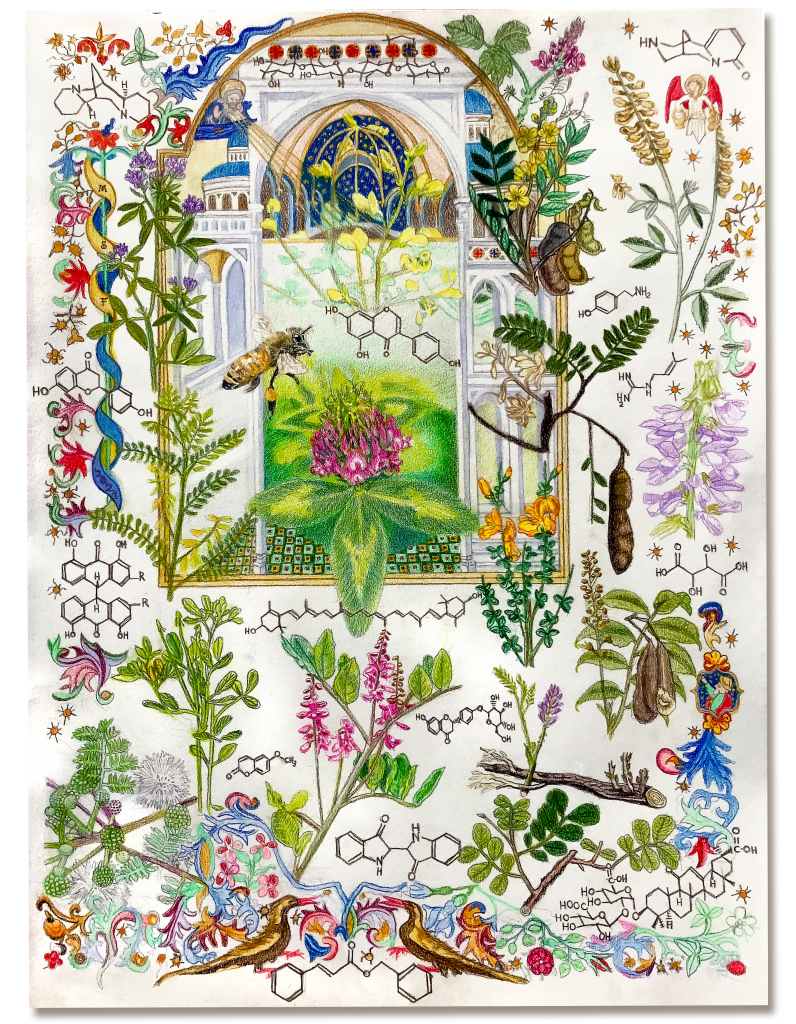
I’ve been doing this during the pandemic as a way to keep myself focused, it’s been a great refresher for me, too, because I’ve had to go back and look at all of the botany again and make sure that I’m drawing it anatomically correct, and looking at the chemical structures and making sure that I didn’t make any mistakes drawing them into the designs. I know that not everybody wants to learn this material, but if you are interested, learning visually is a good way to do it, especially when you start to associate chemical compounds with the plants that they are naturally found in. There’s not a lot of language associated with what I’m doing – it’s mostly symbolism and visual learning. The symbolism of chemistry and its molecules is universal in the world, even though there are some letters in there like ‘O’ for oxygen and ‘N’ for nitrogen. The rest of it is all imagery. Maybe some day there will be a need to preserve the visual component of which plants are in which families containing which compounds – I think that is kind of what I’m doing. Not that this information isn’t out there. I’m just putting it together in a new format because I have the ability to do it, I’ve spent a lot of time learning this knowledge, and now by putting it into a book, I can help other people to learn it, too.
You’ve mentioned that many people encounter difficulties when trying to study and deeply understand phytochemistry and its relevance to herbal practice. Perhaps you can say something about why you feel phytochemistry is important to the contemporary practitioner?
M: I think it’s a great tool; the chemistry is a very valuable tool for us to better understand and work with the plants. Especially when it comes to the solubility of what you are trying to extract from an herb. If you understand the basics of what type of compound, and how it would be classified, and what the basic actions are, and then looking at the basic polarity and solubility, you would know whether you could extract it with alcohol, oil, water, or glycerin – we’re not allowed to use other solvents, in pharmacognosy we had to use a lot of other things that I would rather not have used! It really helps to know if something requires Everclear to extract it because it has a lot of various fatty acid compounds or cholesterol or other very lipophilic compounds that extract well with organic solvents. And then there’s the sugars – if you’re making an immune formula that has a lot of polysaccharides that are complex sugars that stimulate the immune system, then hot water is sometimes sufficient depending on what plants you are using, and what you are trying to extract. Oftentimes there is a mixture within the plant, and that’s the reason that 50% water and 50% alcohol seems to work well – not that it’s a magic ratio or anything, but that 1:1 ratio does work for a lot of herbal extracts, because its right in the middle. Likewise, I am also very interested in essential oils and hydrosols. I got involved with cosmetic formulation and manufacturing for a while. It’s the same thing, just using it for a different purpose – in terms of getting plant extracts and manufacturing products with them – which led me to teaching more about it.
What can you tell us about the book? Does it have a title yet?
M: I’m planning on calling it ‘Illuminated Phytochemistry.’ I’ve created a cover for the book – the cover has the mint family on it and I put some of the menthanes and various terpenes that are in that family on here. That was one of the very first ones that I drew. Like I said, I’m on the 12th or 13th illustration. I’m working on the Mallow family right now. I’ve done the Orchid family, the Apiaceae, Rosaceae, Fabaceae, Asteraceae and Solanaceae [Nightshade] family, to name a few, but I mean there’s hundreds of families, so its unrealistic to think that I can illustrate them all in a reasonable amount of time, which is why I’m just choosing the ones that are of healing, medicinal, nutritional, and/or cosmetic interest. I think it is valuable to organize this information in this way so that you can quickly look at a plant family and see which plants are closely related, and how they are related chemically, so if you didn’t have one plant available, you might be able to substitute it with another plant, or you could see which plants you could extract together because they might have similar solubility or action. This is far from folk herbalism, what I’m doing, since I’ve organized it using the scientific tradition. But I’m really hoping to blend the two. With the art, to use the right side of the brain to teach more left-brain material. I can be very left-brained, but I can be very right-brained, too. It just depends on what I’m focused on at the moment. I think that we can all do that; we just have to believe in ourselves to do it.
We are all conditioned in certain ways and have tendencies towards certain kinds of activities, but the potential for both right – and left – brained activity is always already there, it just depends on the circumstances we find ourselves in and how our minds get awakened.
M: Finding the right teacher can be really important, because sometimes somebody presents this sort of material in a way that is really inspiring to others, as well as in a clear way. You also have to be willing to do the work. When you are getting involved on this level, there is a certain amount of discipline that just comes with the territory, as in running a lab or approaching taxonomy or phytochemistry – these are disciplines that you have to study before you’re allowed to do certain work, there are prerequisites involved. I’ve taken a lot of this material out into the public to teach people who don’t have those prerequisites. In some cases it can be intimidating, but other times it really makes people say ‘wow, that’s cool’ and ‘I wish I knew more’ or ‘I want to learn more’, and those are the people I’ve worked with over the years.
What about the text that is going to accompany the illustrations?
M: The coloured illuminations that I’m doing, I don’t have the publisher yet, so I can’t say if they will all be in the center of the book or will appear as chapter heads for each section. I will probably go from simple to more advanced, starting with the monocots and going to the dicots and ending with the aster family, which is the way that most of the botanical texts go. I might put the illuminated image at the front of the chapter for each corresponding plant family, and then have the text, and then have smaller illustrations of e.g. the shape of a leaf or other types of botanical illustrations that will help people learn the plants. It’s not just about phytochemistry – its bridging botany and phytochemistry together for the purpose of healing arts.
We are trying to compile a contemporary history of herbal medicine at Everything Herbal, and we are asking various people to share their experiences with the evolution of the herbal medicine world as they’ve experienced it.
M: It’s changed a lot since I got involved. I’ve been involved for the last 30 years – big business got involved over that time period. When I first started my herbal company in 1991 there weren’t the regulations in place that there are today. The ‘good manufacturing practices’ are more stringent now than what companies were doing back at that time. Much of it has to do with sterility, cleanliness, proper identification, record keeping, making sure you have good procedures for extracting and preparing your products. They want the products to be good quality, and there are good reasons for those things to be in place. We are now dealing with a corporate, multi-billion dollar global industry. I’m concerned about the plant populations and I’m hoping that they aren’t going to be exploited too much, where we start losing various species of plants due to overharvesting or environmental damage. I saw that – I was one of the earlier members of the United Plant Savers because I was studying with Rosemary Gladstar when they formed that group; they were meeting up at Sage Mountain when I was still a student. There are a lot more organizations today dedicated to conservation, more educational opportunities, and the preservation of the knowledge – including support for indigenous knowledge and indigenous cultures. There is more respect for diversity in general. Lately I’ve seen politics becoming involved too, and people getting upset. I’ve just tried to stay out of that to the best of my ability although I really hope that we can all learn to just get along and respect each other. That’s what the whole human race needs. That’s such an understatement!
Herbal medicine has also been so viciously attacked by the allopathic establishment…
M: I remember when I was pharmacy school everyone was very skeptical of me there at first. The allopathic environment was not pro-holistic. I gave a graduate seminar on the use of hallucinogenic compounds from plants for psychological and psychiatric research and they nearly laughed me out of the room. Now it’s a hot research topic. But 20 years ago, they just weren’t ready for it. All that research started in the 60s, it’s not anything new, but they were just closed-minded to it. This has to do with international patenting laws, what is deemed a drug and what is not, and all the regulations around all of that. I like to point out that the word ‘drug’ comes from the old Dutch word drogge which means ‘dried plant’.
What are some of the directions that you’d like to see herbal medicine move into?
M: I think it has moved a lot, I don’t know that I’m the right person to say what it should be for other people, but I would like to see it more accepted by science as something valid. I’d like to see the scientists have a more diverse approach, where they can incorporate nutrition, herbs, as well as allopathic medicine and various types of physical treatments into their practices. I think we are moving in that direction. I don’t think the insurance companies are ready to jump behind it, and go along with it as part of standard practice, though. I guess it depends on where you are and who you are working with. I’m surprised to see, still, the amount of resistance that is out there from some people. But it’s not my place to judge. They have a lot better marketing programs – the pharmaceutical companies.
Maybe you’d like to talk about your interest in psychoactive plants. It is a topic that can be quite polarizing – you have some herbalists that are strongly opposed to the use of psychoactive and entheogenic plants and other herbalists that totally embrace and are very excited by the potentials behind such usage.
M: I can clearly see that there’s a polarity there. I don’t see any reason why these plants can’t be used, at least experimentally as medicines, when we have allopathic medicines that have all sorts of bad side-effects and that people are supposed to stay on for long periods of time. Some of the shamanic techniques that are being tapped into are helping to release trauma through using these types of compounds. There was often some kind of ceremony or ritual, someone observing a person to ensure their safety, and done in a context of working under somebody who was experienced and knowledgeable. We’re not talking about someone who wings it, because then they are risking the possibility of things going wrong. I don’t want to say one way or the other – I don’t have a problem with people using these plants traditionally, but I don’t want to sound like an advocate either.
It depends on the individual and their need for therapy. I understand that it goes beyond that – there’s a whole culture of people who have used these things for other purposes, going back to the hippies and the 60’s and the Grateful Dead & psychedelic rock… I’m not even old enough to have been around for that, though I appreciate the music. People are going to use various substances whether they are allowed to or not. It is better to be safe about it, and perhaps if there was more education available… I don’t want to sound too idealistic in my thinking. I think it’s a shame that there’s so much drug abuse in our culture. We should be looking at why people are engaging in this kind of behaviour. Instead of blaming the drugs, let’s look at the definite social and cultural issues that are lying at the root of this behaviour. Let’s learn to use the compounds and plants more intelligently. I hope that someday we have a system that is more conducive to that, more accepting of that.
It’s interesting to observe the contemporary psychologists and psychiatrists who are using psychoactive plants and compounds in a therapeutic context. Some of them are doing interesting work, but it’s always within the confines of the psychiatric model. Definite limitations are set: we’ll allow you to experiment, but only if you are doing so within our officially sanctioned framework. Forget about traditional use, they’re not interested in traditional use. There is the traditional medical pharmaceutical model, which is open to very minor modifications, and that’s what you have to exist within if you are to be granted any kind of legitimacy.
M: The medical field tends to do that, to compartmentalize in that way. I’m not saying it’s the only way to approach it, but if you were going to investigate, there are maybe other ways, such as working with indigenous peoples and finding healers who are educated, and who can assist people with the use of these plants. There’s always a potential for someone to have a bad trip or to harvest the wrong plant or take too much of something and have a bad reaction, and you don’t want that to happen. This work certainly has the tendency to bring up people’s traumas, and if they have traumas and haven’t healed them, then there’s a chance that they might be triggered.
What do you feel herbal medicine has to do with understanding ecology and sustainability? Can you share some thoughts about the relation of herbal medicine to ecology generally?
M: I think that herbalism is one big part of our survival skills as a species and it’s probably the oldest, or one of the oldest, of such skills. And because of that it evolved a lot differently than lot of other systems that are operating now. A lot of the way things are operating now, in broader context, is based on corruption, a corruption of science, with the aim of trying to create global monopolies, which they have done. Humanity needs to live in balance with nature, it would certainly behoove us to, and herbal medicine is a huge part of that. It is very important that we preserve these traditions, that we continue learning and researching, and that we teach our children and grandchildren, and the future generations. That is a constant, that has always been the case, but even more so now because we have so many competitive fields that are against what it is that we are doing. It is all the more important for us to preserve what we have, updating it, and passing it forward. I hope that the future generations can use all of this as a key to living in harmony with nature and figuring out the various health problems of humans and animals. There is so much potential, it’s just a matter of getting enough of our collective attention focused on that potential. The people around the world are pretty united – a lot of people use plants, all over the world. That kind of a movement can be supported. It’s already there, but it’s an underground movement. I just don’t want to see it become further exploited into some kind of unappreciated resource that does even more harm to the planet.
Then it becomes a vicious cycle, the deeper the patterns and cycles of dissociation humans end up falling into the greater and more difficult are the perils we have to face in the long term. It’s one big self-defeating cycle. It can be said that the disease process often develops as a way of pointing out what the error is in our way of being in the world, disease as a means of making you as an individual aware of what you need to change or shift in your life. When you suppress that information either in an individual body or in the context of a larger ecological matrix, then you are simply creating an even more chronic, long-standing condition that is even more difficult to cure.
M: I agree. I would like to see the system less profit-oriented, too. I’m in no place to make that happen. It’s a shame that things have to be all about money when we are working with curing diseases.
Anything else you’d like to discuss or share?
M: I am going to be producing a website, I’m going to be selling botanical prints and some of the art I’ve been creating outside of publishing it outside of the book. There have been a lot of requests for posters, t-shirts. I have been posting the images on my Facebook page as I’ve been creating them, so I will likewise be posting more information regarding that.
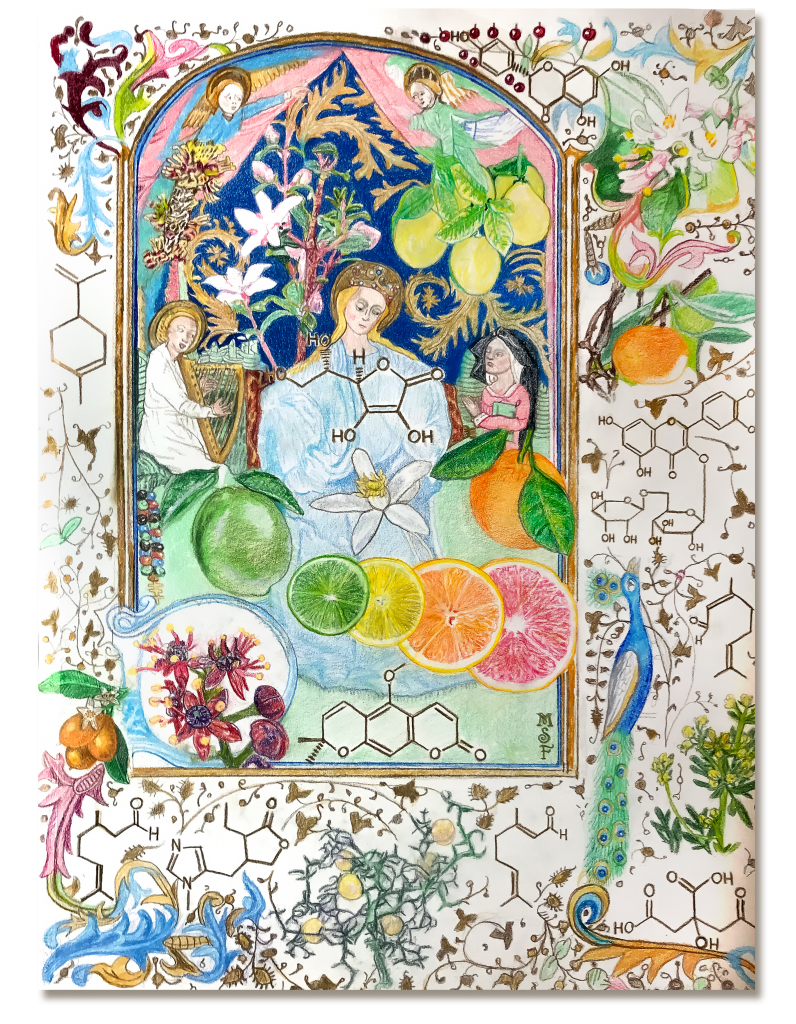
If you would like to check out more of Michael’s work and follow the journey of his book, you can find him on Pintrest.
Herbal Actions: Bitters
Herbal Actions
What is a “herbal action”?
When we speak about the action(s) of a certain plant, we are referring to one or more effects a plant can have on our body. Often these actions are explained in two or three words; however, herbal actions are so much more than that! Since plants are wonderful complex beings, they also have several actions. Most herbs can compliment their action(s) in combination with another herb, basically showing off their best side with the support of a “good friend”. Sometimes they work great on their own, but most of the times, they excel with a good buddy on their side. Think- Teamwork!
Bitters
In our modern “western” diet, there are only a handful of bitters that have established themselves into restaurants and home kitchens. But then, most of the time, the natural bitter taste of these power foods is reduced by for example sprinkling sugar on a grapefruit or by offering caramelized Brussel sprouts instead of experiencing the real deal. How about a good, bitter coffee? Well, most decide to add a big load of sugar into their dark brew… It almost seems like the naturally occurring bitter taste has become the enemy.
How did we get there? Considering the endless health benefits of bitter plants and foods, why do we try to either mask them or associate them with something bad?
Where our ancestors diet mainly consisted of foraged foods, including lots of bitters, it seems that our modern culture has been taught to like sweets, and dislike bitters. A lot of times when we taste something bitter, we think “Eww! That’s so gross!”. But how about don’t engage in this kind of thinking; how about we go “Wow! That is so POWERFUL!!” Because that is exactly what it is! It is within our power to take away that judgement and re-train our brain. Do you want to join? Let’s try something.
A very wise and experienced herbalist once shared with me how to get my kids to like/ be okay with bitters – lucky for everyone, this technique also works extremely well for grown ups. Yay!! Ready?? Go outside and pick either a dandelion leaf (a mild bitter) or, for a stronger bitter experience, pick some Yarrow or Mugwort. After a nod of gratitude and making sure it does not come from a sprayed lawn or has seen frequent pet-traffic, go ahead and nibble on it. Now try to experience the following:
Phase 1 – Brain response: Our body notices we are chewing on something bitter – Think: WOW!! This has power!
Phase 2 – Contraction: Now it is time to surrender; let your body feel this power and do not fight it or hold the contraction. How does it make you feel?
Phase 3 – Relaxation: After the initial “power-shock”, can you feel how your system is relaxing? Can you feel how your digestive tract is responding; producing a pleasant warming feel in your stomach? Can you feel how your gut-brain connection is not just helping to relax your gut, but also your nervous system?
BITTERS FOR POWER!!
Try this with many different bitter tastes and gradually increase them in your diet. It is also super beneficial to get into the habit of taking bitters just before a meal. But more on that in a little bit…
But, How Bitter is Bitter?
Sometimes you can find a number referring to how bitter a plant is. The number of 1000 for instance describes that 1g of the plant substance can still be experienced as bitter in 1000ml of water.
To get an idea of how bitter some plants are, let me share a few of these bitter numbers:
| Taraxacum officinalis (Dandelion) | 100 |
| Orange Peel | 600 |
| Alchiella millefolium (Yarrow) | 3.000 – 5.000 |
| Artemisia vulgaris (Mugwort) | 10.000 – 20.000 |
| Artemisia absinthium (Wormwood) | 10.000 – 30.000 |
| Gentiana lutea (Gentian) | 10.000 – 30.000 |
A bitter herb like Wormwood tastes so bitter and bile-like, that you cannot simply “wash it down” with a cup of water or something even stronger. Its bitterness is so intense that it can be felt in both your mouth and esophagus for an hour or more afterwards.
How Bitters Work
Bitters can have positive effects on many body systems. In this post I will be focusing on the bitter action on the digestive tract.
As the traditional German saying has it: “Was bitter im Mund, ist dem Magen gesund” – ‘What’s bitter on the tongue is healthy for the stomach’.
Interestingly, bitter taste receptors are not only found in the mouth, but also in the respiratory tract, the liver, the GI-tract, parts of the urogenital tract and other places in the body.
Bitters are intense communicators; when tasted by the tongue, they literally demand attention and provoke a response. The first response happens right away in the mouth as the salivary enzymes get ready for action and salivation increases. Saliva moistens the food and contains enzymes like amylase and lingual lipase. Amylase breaks down starches into sugars for easier absorbed by the body, and lingual lipase kickstarts the break down of fats.
Besides the increase of salivary secretions, messages are sent to the digestive system, signaling the release of the digestive hormone gastrin. Peristalsis, the wavelike motion of the digestive system that stimulates the motility of food along the digestive tract is prompted as well. The digestive tract is encouraged to start properly breaking down food and ensuring optimal absorption of nutrients.
Among Many Other Actions, Bitters:
- Trigger digestive functions
- Stimulate the release of digestive juices
- Increase the flow of bile
- Aid the liver in detoxification work
- Promote intestinal motility
- Are tonifying
- Stimulate appetite
Using Bitters and Preparations
Many herbalists suggest using bitters in form of a tincture. Especially for digestive uses, bitters should really be tasted. A lovely herbalist friend of mine once suggested putting them into a small spray bottle for easier use. This excellent technique makes it really easy and convenient to “quickly” take your bitters.
Otherwise, befriend the powerful bitters and add as many as you can to your regular diet. Start slowly and increase the addition of bitters and reduction of sweetness.
Alternatively, any bitter can also be taken in the form of a tea as gentle decoction. As many bitters also contain aromatic compounds, keep the lid on while decocting and carefully add the accumulated drips on the lid back into your brew. A bitter tea, however, may not be your first choice if you are new to the bitter taste.
Those Who Should Avoid Bitters – Contraindications:
Pregnant women may want to stick to very mild bitters as stronger bitter can potentially cause cramping. Before taking bitters, contact a professional herbalist if you are experiencing heart burn or gastroesophageal reflux disease. They will be able to help you determine if bitters are going to be helpful or possibly worsen the situation. A further contradiction from bitters is if one is suffering from kidney or gallstones. For those with a generally cool/dry constitution, add some warming spices (like ginger or thyme) to counter the generally cooling energetics of bitters.
Examples of Some Bitter Herbs
Lovely bitter herbs to support the digestive tract include;
- Rumex crispus (Yellow dock)
- Gentiana lutea (Gentian)
- Taraxacum officinalis (Dandelion)
- Artemisa vulgaris (Mugwort)
- Matricaria recutita (Chamomile)
I hope this post gave you a little insight on Bitters and how they can interact with our body. This topic is covered much more in depth in the herbal course, which is currently developed and coming soon by our group of wonderful herbalists.
Resources:
Besides my own words, this write up features information from the following resources:
– Ursel Buehring Praxis- Lehrbuch Heilpflanzenkunde – Grundlagen – Anwendung – Therapie. 4 ueberarbeitete Auflage. Karl F. Haug Verlag in MVS Medizinverlage Stuttgart GmbH & Co. KG’ 70469 Stuttgart, Germany. 2014. (Published in German language)
– Jim McDonald – Foundational Herbcraft – www.herbcradft.org – collected writings from www.PlantHealkerMagazine.com.
– David Hoffmann – Medicinal Herbalism: The science and practice of herbal medicine. Healing Art Press, Rochester, Vermont 05767. 2003.
– Lisa Ganora – Understanding Herbal Constituents and Plant Chemistry (2007)
Rhubarb Shrub Recipe and Companion Plants
The Mighty Plant: Rhubarb!
Just say the word Rhubarb, and childhood memories come flooding back! My sister and I barefoot in the garden on a sunny morning, with a tin cup of sugar, picking just the right piece of rhubarb for our tasty spring treat. Ah that first bite, crunch! Oh so tart! then dip, and oh, so sweet! We waited all year for these special garden moments
Rhubarb is most often thought of as a vibrant fruit because of its sweet, tart taste, and is often found in home baking, such as a rhubarb pie, but did you know that it’s actually a vegetable? Cross my heart! Come to think of it, there is a strong resemblance to celery. While technically it is a vegetable, legally it’s considered a fruit due to a 1947 court ruling in America. Interesting eh?
Rhubarb, part of the Polygonaceae family of plants (perennial), is a unique looking plant with a remarkably interesting history. The rhubarb plant was originally used in many forms of traditional medicine, first showing up in Europe over 400 years ago. It’s fascinating to share that there are records showing rhubarb among the medicines traded along the Silk Road. Scientifically, it is an herbaceous perennial with leaves growing off the top of a thick rhizome. The leaf stalks and seeds are the only parts of the plant consumed. The heart-shaped, wide-veined leaves contain oxalic acid, which can be toxic when consumed in large quantities, so discard them before you use or store the stalks. As a gardener I love the beautiful addition rhubarb offers the landscape thanks to these large leaves and colourful stalks.
Harvesting
Rhubarb season runs from April through June. When harvesting, the stalks are carefully pulled or cut from the rhizome, and the toxic leaves are removed right away. Plants can generally be harvested for a four-week period in the third year and for around eight to 10 weeks in subsequent years.
How to Freeze Rhubarb? Simply pick and chop off the leaves, wash and pat dry the stalks. Chop into small even pieces. Put in a freezer bag and empty it of all the air (I measure 4 cup amounts because this is how much we need to bake a 9 inch pie). Put in a freezer and use throughout the year. Make sure to thaw and drain the frozen rhubarb before using it!
So, What is a “Shrub” Anyway?
It sounds all fancy dancy, but a Shrub is a super easy way of preserving fruit. Before we had refrigerators, our grandmothers were using many ways to preserve nature’s bounty. Canning, curing, smoking and dehydrating (which all sound very familiar) , but shrubs – also known as drinking vinegar – might be something new to you. A shrub is just a simple fruit syrup fortified with vinegar instead of water for preserving the essence and flavour of the plants being used. The vinegar continues to work with the sugars, and over time, creates a twist … mellowing and melding into a wonderful concoction. The tangy rhubarb shrub can be added to water, mineral water, sodas, or spirits for a refreshing tart drink. I also like to add a kick of ginger or some heavenly mint from the garden! Be inventive; try adding a splash of fruit juice, herb and spices to make a new drink each time.
Shrubs were popular during 1600s, 1700s and 1800s and has been making a come back for some time. Now appearing in specialty shops being used most commonly in craft cocktails, or mocktails. I LOVE the saying, “everything old is new again”. Ain’t that the truth!
This traditional treat is welcomed on a hot summer day or makes a lovely gift!
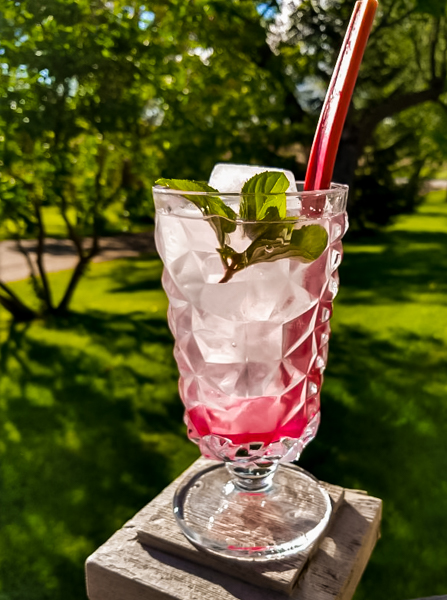
My Mom’s Rhubarb Shrub Recipe
Ingredients:

- 6 cups of freshly picked Rhubarb
- 1 ½ tsp dried ginger (optional)
- ¾ cup apple cider vinegar (can also use white or red wine vinegar or water)
- 3 hand sized pieces of Sweet Cicely leaf
- ¾ cup sugar (if not using Sweet Cicely, sugar should be 1 ¼ cups)
Directions
Wash rhubarb and sweet cicely. Combine chopped rhubarb, sweet cicely, sugar, ginger, and vinegar in a medium saucepan. Cover and bring to a boil over medium-high heat. Once boiling reduce heat to low. Cook, stirring occasionally, until rhubarb is completely broken down and strands are visible, 15 minutes.
Use a fine mesh sieve or colander lined with cheese cloth and strain mixture into a glass container. Let cool and then chill.
Voila! Shrub is ready to use.
For a refreshing drink simply add 1/8th cup (1 oz) of shrub to the bottom of a tall glass, fill with ice and top with water or sparkling water. Top with a mint leaf and small stalk of rhubarb. Optional: add a splash of juice, vodka, gin, gin smash or Tom Collins.
** Note: Any left over rhubarb can be frozen for later use. I always pick extra and bag up 4 cups of cut rhubarb with a leaf of sweet cicely for baking a pie or crisp when rhubarb is out of season.
Companion Plant Pairings for Your Garden: Rhubarb and Sweet Cicely
Plants grow better with a little help from their friends. The practice of planting different varieties of plants together is known as companion planting and can help ensure a healthy harvest of both crops. Rhubarb and Sweet Cicely are a perfect pair. They have been growing harmoniously side by side in my old vegetable garden for years. But the best part is they are ready at the same time! They are a delight to any gardener who loves Rhubarb but does not want a ton of sugary desserts. Sweet Cicely helps you to cut the amount of sugar in any given recipe by almost half. AMAZING!
Other kitchen pairings:
Sweet shrubs: strawberries or blackberries with mint, sweet cicely seeds with pineapple, or peaches with basil.
Savory shrubs: tomato shrub infused with chilies and cilantro, cucumber with fresh ginger, or celery and caraway seeds.
Medicinal Information
Sweet Cicely
- Aromatic, stomachic, carminative and expectorant. Possible diuretic
- Useful in coughs and pleurisy
- Gentle stimulant for debilitated stomachs. Useful in flatulence
- The fresh root may be eaten freely or used in infusion with brandy or water. A valuable tonic for girls from 15 to 18 years of age
- The roots are antiseptic, and a decoction is used for bites of all kinds through bugs to animal
- The essence to be aphrodisiac
- The decoction of roots in alcohol is also said to be effective for consumption
- Ointment made eases the pain of gout
Rhurbarb
- Eases digestion: the fiber in rhubarb promotes a healthy and normal digestion process and eases abdominal discomfort such as bloating and cramping
- Bone health: the vitamin k, combined with the rich amount of calcium and other minerals found in rhubarb, promote bone protection and strengthening. The high amounts of vitamin K also promotes osteotropic activity, meaning that it stimulates bone growth and repair
- Brain health: protecting the brain from neurological damage and disorders, such as Alzheimer’s
- Antioxidant: fights free radicals and keeps inflammation in check
- Relieves constipation and diarrhea: as it eases digestion, it can also relieve constipation and diarrhea
- Lowers Inflammation: the antiviral effects of rhubarb also help inhibit inflammation, making it an effective anti-inflammatory
- Aides Perimenopause and Menopause symptoms such as hot flashes.
- Menstrual cramps
- Nutrient: containing calcium, vitamin K, A and C, potassium and manganese.
- Weight loss: rhubarb is very low in calories and the high fiber content helps you feel full faster
- Heart Diseases: the high fiber content is extremely useful in lowering cholesterol levels
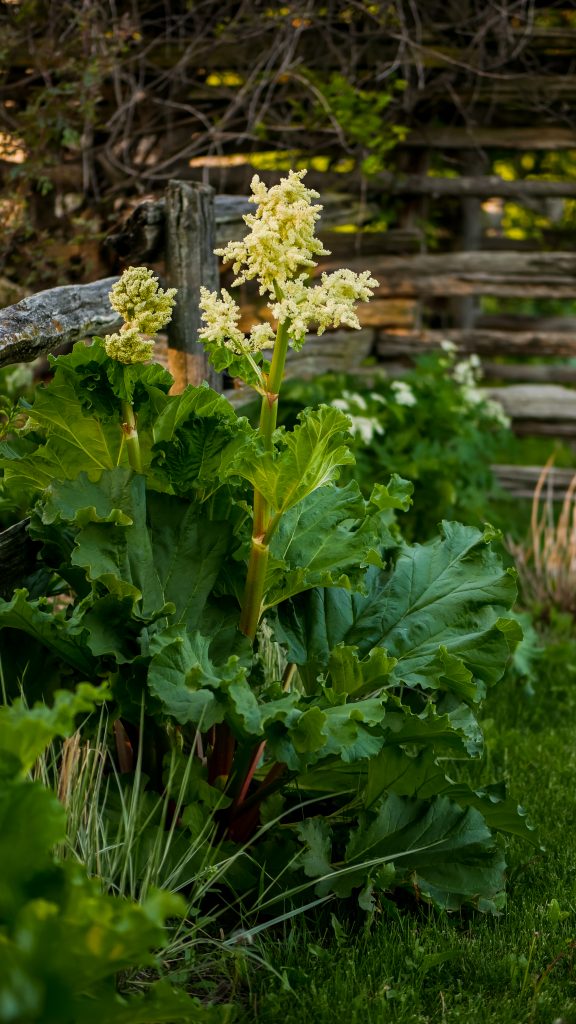
Herbal Actions: Demulcents
What is a “herbal action”?
When we speak about the action(s) of a certain plant, we are referring to one or more effects a plant can have on our body. Often these actions are explained in two or three words; however, herbal actions are so much more than that! Since plants are wonderful complex beings, they also have several actions. Most herbs can compliment their action(s) in combination with another herb, basically showing off their best side with the support of a “good friend”. Sometimes they work great on their own, but most of the times, they excel with a good buddy on their side. Think- Teamwork!
Demulcents
Let’s have a talk about our “Gentle Healers”. Not only are demulcent herbs soothing and gentle, but they also tend to be very nutritive. They are gently supporting and helping us to heal. A group of herbs you simply have to love…
Demulcent herbs are rich in carbohydrate mucilage, which is composed of heteropolysaccharides (various forms of sugars). These posses the ability to bind themselves to water, which will then turn viscous/gel like and stick to the surface of the plant material. Have you ever made yourself a pot of chia pudding? You may have noticed how the dried seeds swell up after a few minutes of being exposed to water (both warm or cold). They can build what seems like a soft cocoon of viscous mucilage around them. A leaf of common mallow will also easily demonstrate this effect – notice how after a few times chewing your saliva turns viscous and gel-like?
Did you know that some plants like to use this feature of the mucilaginous, “slimy cocoon” to spread their seeds? When ingested by animals, the protective coat often helps prevent the eaten seeds from being digested. You can guess what happens next… The animals defecate the coated seeds and give them a little boost with their very own fertilizer. Fascinating!!
Generally Speaking, Demulcents are Indicated in:
- Dry, tight tissues
- Inflammation with dried out mucous secretion
- To cool, coat and soothe
- To stimulate peristalsis in constipation
- As binder in cases of diarrhea
- Soothe stomach and esophageal tissue from acid burn
- Prevent ulceration
- Irritations in the urinary tract
- As lubrication and skin emollient
The energetics of demulcents are fairly straight forward; they are generally moist and tend to be cooling. Due to the polysaccharides, they tend to have a sweet taste. We also have to remember that the energetics of a herbal action are more of a guideline. Considering the individual herb to more properly “classify” its energetics is the right path to go.
Examples of Some Demulcent Plants
Demulcents for the digestive tract:
Althea officinalis (Marshmallow), Plantago scarba (Psyllium husk) or Linium usitatissimum (Flax seeds). Demulcent herbs have to ability to lay a protective coat over mucous membranes and other tissue it comes in contact with. Therefore, demulcents used in the digestive tract have the ideal conditions to show of their best side.
Demulcents for the respiratory tract:
Verbascum Thapsus (Mullein), Tussilago farfara (Coltsfoot), Althea officinalis (Marshmallow). By providing a protective coat over the inflamed airways, demulcents soothe and function as analgesics, anti-inflammatory and as protective layer over the mucous membranes.
Emollient herbs for the skin:
Linium usitatissimum (Flax seeds), Symphytum officinale (Comfrey), Althea officinalis (Marshmallow). Many herbalists refer to mucilage internally used as demulcents and topically used as emollients. Emollients help provide flexibility to dry, irritated and inflamed skin conditions. Often times, applying the herb in form of a poultice seems to work very effectively.
Demulcents for irritation in the urinary tract:
Elymus repens (Couch grass), Zea mays (Conrsilk) and Althea officinalis (Marshmallow) are all excellent demulcents for any irritation, burning, and other irritable sensations in the urinary tract and have been used very successfully over many generations. Diuretics working on solid material work best with the assistance of lubricating demulcents.
Preparing a Cup of Tea
Traditionally, most demulcents are prepared via cold infusions. The reason behind this is that we are focusing to mainly extract the mucilaginous polysaccharides – our gentle healers… If you are preparing milder or more complex demulcents, you might be looking at a hot infusion.
A very effective way is to infuse 1-2 tbsp of dried herb into 1 liter of cold water. Let this sit overnight. In the morning, you have a wonderful soothing infusion. You could also just let it sit for a few hours, but the longer the herb infuses, the more viscous the tea will get.
Especially on hot and dry days, you might want to consider adding some Althea officinalis root to your water; it will help you stay better hydrated and tastes super yummy!
I hope this post gave you a little insight on demulcent herbs and how they can interact with our body. This topic is covered much more in depth in the herbal course, which is currently developed and coming soon by our group of wonderful herbalists.
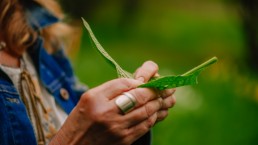
Comfrey Leaf (Symphytum officinale)
Resources:
Besides my own words and oral teachings from many wonderful herbalists, this write up features’ information from the following resources:
Ursel Buehring Praxis- Lehrbuch Heilpflanzenkunde – Grundlagen – Anwendung – Therapie. 4 ueberarbeitete Auflage. Karl F. Haug Verlag in MVS Medizinverlage Stuttgart GmbH & Co. KG’ 70469 Stuttgart, Germany. 2014. (Published in German language)
Jim McDonald – Foundational Herbcraft – www.herbcradft.org – collected writings from www.PlantHealkerMagazine.com.
David Hoffmann – Medicinal Herbalism: The science and practice of herbal medicine. Healing Art Press, Rochester, Vermont 05767. 2003.
Abrah Arneson – The Herbal Apprentice: Plant Medicine and the Human Being – Green Heart Press. 2014.
Matthew Wood – The practice of Traditional Western Herbalism – Basic Doctrine, Energetics and Classification – North Atlantic Books, Berkley, California. 2004.
Rosemary Gladstar –Rosemary Gladstar’s Herbal Recipes For Vibrant Health: 175 Teas,…- Storey Publishing, LLC – September 3, 2008
Talking About: Adaptogens
Adaptogens
What Are Adaptogens?
Often times, we have to just listen very closely to a client’s story and they will actually tell us the answer themselves. The same concept applies to the term “adaptogen” – listen closely “adaptogen” – “to adapt” – “adapting”… Looking at it from a broad view, this is what this group of herbs does. Adaptogens help us adapt to both environmental and psychological stresses.
It is said that 75% – 90% of all doctor visits in North America may have a stress-related component. Clearly, our bodies are sending us signals – these signals can include loss of interest, poor memory or feelings of worry and fear. Symptoms can also include (but are obviously not limited to) manifestations which we may not even relate to stress; like feelings of tension, fatigue or digestive issues.
If our body is unable to naturally recover from stress, there are two essential ways to support it in its ability to cope and recover. The first one is to address the initial stressors and find ways to limit the root cause. The second is to introduce the “super-heroes” of the herbal world – Adaptogens.
Any reputable herbalist will support clients in both ways. They will help find a herb that suits the individuals needs best, usually within a personalized formula, but will also share effective techniques to help cope with stress and exhaustions.
In summary, adaptogens:
- Increase resilience
- Increase physical performance
- Increase coordination, cognitive performance, memory and concentration
- Improve mental and physical activity and stamina
- Have a tonifying and immunomodulating effect
Getting a Hand on the Root Cause
Yes, adaptogens are amazing. They are the number one group of herbs to help us become more resilient to stressful situations and support our organism when suffering from stress related fatigue and other symptoms. However, when working with adaptogens, we have to keep in mind that they can certainly help us “adapt”, but also, adaptogens will only effectively work long term if we also address the root cause that has brought one to this state of physical and emotional exhaustion. Biological stressors, chemical stressors, consumable stressors, environmental stressors, psychological, physical, as well as spiritual stressors all have to be addressed. Trying to fix symptoms instead of addressing the root problem can be dangerous.
Apoptogenic Herbs
If you think adaptogens are what’s needed in your life, be sure to find the right one for YOU. Adaptogen isn’t always adaptogen. For example, if one lit their candle on both ends and as a result crash and are burned out, a relaxing adaptogen like Ashwagandha might not be the first choice. We might want to work with a more stimulating herb like Rhodiola. But even then, if the client’s constitution tends to be rather dry, Rhodiola might, in the long run, irritate even more. Therefore, in order to receive the best long lasting results, it is always advised to contact a professional herbalist to help find which adaptogen might work best.
Examples of Some Apoptogenic Herbs
Rhodiola rosea (Rodiola) – Stimulating
Can help with brain fog, increase concentration, memory as well as mental capacity. Has also been recognized to help with depression, particularly the “winter blues” (SAD).
Eleutherococcus senticosus (Eleuthero, Siberian Ginseng) – Stimulating
Eleuthero is helpful for those who can’t get out of bed, even after a full night of sleep. For those dragging through the day, foggy brain… Eleuthero supports a depleted immune system by promoting natural detoxification processes in the liver.
Withania somnifera (Ashwagandha) – Strengthening without stimulating, calming
Particularly helpful for individuals who seem depleted and “worn out”. Has been used to heighten intellectual capabilities and longevity, for those with insomnia, wired/cloudy thinking and fatigue. Ashwagandha has improved long and short-term memory in people with mild cognitive impairments and has successfully been used those with OCD and ADHD.
Schisandra chinensis (Schisandra) – calming
Schisandra creates a calm feeling while increasing focus and gently boosting physical energy levels. It has hepatoprotective properties, meaning that it is liver protecting and blood purifying. Schizandra is thought to enhance the endocrine system and nonspecific immune system function, which is the one most affected by stress.
Ocimum sanctum (Tulsi/ Holy basil) – relaxing
This calming and relaxing adaptogen has been successfully used to help manage stress, poor memory, anxiety and be of support when one feels irritable. Tulsi clears the Aura, gives the power of awareness and harmonizes. Tulsi may also be beneficial in cognitive disorders such as Alzheimer’s disease and dementia.
I hope this post gave you a little insight on adaptogenic herbs and how they can interact with our body. This topic is covered much more in depth in the herbal course, which is currently developed and coming soon by our group of wonderful herbalists.
Resources:
Besides my own words and oral teachings from many wonderful herbalists, this write up features’ information from the following resources:
Ursel Buehring Praxis- Lehrbuch Heilpflanzenkunde – Grundlagen – Anwendung – Therapie. 4 ueberarbeitete Auflage. Karl F. Haug Verlag in MVS Medizinverlage Stuttgart GmbH & Co. KG’ 70469 Stuttgart, Germany. 2014. (Published in German language)
Jim McDonald – Foundational Herbcraft – www.herbcradft.org – collected writings from www.PlantHealkerMagazine.com.
Abrah Arneson – The Herbal Apprentice: Plant Medicine and the Human Being – Green Heart Press. 2014.
Paula Grainger – Adaptogens, Harness the power of superherbs to reduce stress & restore calm – Octopus Publishing Group Ltd. 2018
Adriana Ayales – ADAPTOGENS, Herbs for Longevity and Everyday Wellness – Sterling Publishing Co., Inc., New York. 2019
https://www.webmd.com/balance/stress-management/stress-and-the-body
Conversations with Nick and Penny: Why "Everything Herbal" and Why Now?
Question: Why "Everything Herbal" And Why Now?
A Conversation with Nick and Penny
Our Primary Objective
Our primary objective is to give back to the herbal community for all that it has given to us. We aim to support and help uplift herbalists in Canada and abroad, and promote the vital work that plant people have tirelessly dedicated their lives to.
It is really important to us that we help and support herbal enthusiasts and practitioners of herbal medicine and their patients. We want to help students and those with a general interest in plant medicine to find premium quality, sustainably and ethically produced medicines and supplies. Those who are looking to learn about herbal medicine need to be able to find accurate and reliable educational resources. How best to grow herbs. How to source plants and seeds. How to spread awareness of endangered plants and help restore and bring vitality back to our increasingly threatened ecosystems.
A Reliable Source for Information
Sadly, there are too many places online where disinformation runs riot, and this only serves to demean the work of the herbal community at large. We are here to uplift and support our community, not just to be critical and point fingers. Now is the time for us to join together and help spread the news of herbal medicine to everyone. Herbal medicine is, and always will be, the medicine by and for the people.
The Everything Herbal team has decades of combined experience in all aspects of herbal medicine, from the field to the consulting room. Some of the members of our team are getting older, and would like to pass on the experience that they have acquired. Herbal medicine has always been a generational practice. Both teachers and students benefit when knowledge is transmitted in this way. In a field so vast and complex, it is easy to make mistakes, but when the younger generation works with its elders the integrity of the work that is carried out can be maintained at a higher level. Learn from those that came before you and avoid repeating their mistakes. Then create something even better!
Having spent a lifetime working in the herbal medicine world and dealing with the forces of industry, we have seen more than our fair share of deceit, manipulation, lies and untruths. It is unethical and cruel to sell products based on lies, hype, and inflated marketing claims. Rather, we believe in working from a rooted foundation, with solid science, detailed study and rigorous experience backing what it is that we do. With the over regulation of herbal products in Canada and the EU, for example, much of the skill, science and art of herbalism has been taken away from many herbalists and ensconced in the bureaucratic establishment, doled out and monetized, to those willing to play the game.
Back to Herbal roots
Yes, we want Everything Herbal to be subversive - but in a positive way. Just because you are told not to do things by those who don’t know any better, does not mean you cannot or should not. Many important herbs have been restricted by the medical establishment, and become out of the reach of real herbal practitioners. Much herbal tradition has been forgotten, including a great deal of insight from the folkloric, mystical and magical traditions of the past, which have been victimized and denigrated through prejudice and fear.
We care deeply about bringing herbal medicine back into everyday use. In the industrialized world, much of the common household knowledge that was held by our ancestors and used to help maintain the health of the community, has been forgotten, and even disparaged. Reviving this forgotten knowledge will help sustain our society, and play a major role in creating a healthier, happier and more equitable and compassionate world.
It is not our intention to cast ourselves as the authority on anything. Quite the contrary. Our aim is to bring us all together and to help create a brighter future under the banner of humility, mutual cooperation and respect. When we work together as a community our shared knowledge and experience will be taken more seriously and will be shown the respect that it deserves. Genuineness and truthfulness are at the core of this endeavor.
Many of us in the herbal community have been isolated from each other for far too long. We are looking forward to creating a brighter, greener future, together.

If you have any questions or topics you would like us to talk about and discuss, please send us a message or email!
Herbal Actions: Aromatics
Herbal Actions
What is a “herbal action”?
When we speak about the action(s) of a certain plant, we are referring to one or more effects a plant can have on our body. Often these actions are explained in two or three words; however, herbal actions are so much more than that! Since plants are wonderful complex beings, they also have several actions. Most herbs can compliment their action(s) in combination with another herb, basically showing off their best side with the support of a “good friend”. Sometimes they work great on their own, but most of the times, they excel with a good buddy on their side. Think- Teamwork!
Aromatics
Imagine walking through your garden, on your favorite trail, or through the quiet woods. Try to picture this beautiful abundance of growth using your senses. Can you see all the different colors, hear the leaves dancing in the light breeze, feel their softness or even their sharp thorns on your skin? Can you smell the plant? No? Try crushing a leaf… How about now? Can you give it a little taste test? Mild? Bitter? Pungent maybe?
If you have been learning from and with our wonderful plant friends, chances are, you have come across the term/action, “aromatic”. Now let’s get back to our imaginary herb walk from just moments ago. It was right there were you have come across a “sense-able”, or “foundational” (as Herbalist Jim McDonald calls it) action of an herb. An action you can immediately experience using your senses.
When talking about aromatic herbs, we refer to herbs one can easily smell by releasing their oils (referred to as volatile oils or essential oils) from their special secretory structures, such as oil cells, epidermal hairs or resin ducts. Most of the time, this release of oils happens, when the leaves or other plant parts have been crushed.
Did you ever ask yourself why a plant even has all these essential oils and/ or amazing actions? They actually have a variety of natural functions within themselves and act for example as growth regulators, protection from heat or cold or serve, for interplant communication or to attract pollinators.
Before giving you a little glimpse on how aromatic herbs can support our body, please let me clarify that I am writing about aromatics and the action of essential oils within the whole plant, and not the distilled, isolated essential oils (EO) you can buy in little brown bottles. Due to the isolated EO’s high potency, they act very different on the body and should be only used with care and the support of a trained aromatherapist.
Examples of some Aromatic Herbs
Lovely herbs for the respiratory system include Angelica archangelica (Angelica) or Thymus vulgaris (Thyme). With both of them being expectorant, anti-microbial and anti-spasmodic, the volatile oils in the plant help liquify the mucous in the bronchi and transport it upwards via a productive cough.
Lavendula (Lavender) is a wonderful relaxing nervine. Coffee spp. (Coffee- anyone?) on the other hand, is a fabulous stimulating nervine (please note, coffee will only excel if used in moderate doses and if you rule the coffee, not the coffee rules you…) – you got it, both aromatics can be used to address the nervous system.
Often aromatics are referred to as carminatives. I personally see the term carminative as a sub-category to aromatics, specifically in regards to the digestive system. Aromatics/ carminatives are of great help when, for example, fermentation in the stomach becomes a problem. My favorite herbs for the digestive tract include Zingiber officinale (Ginger), Foeniculum vulgare (Fennel) or Matriacria recutita (German Chamomile)
I hope this post gave you a little insight on aromatic herbs and how they can interact with our body. This topic is covered much more in depth in the herbal course, which is currently developed and coming soon by our group of wonderful herbalists.
Resources:
Besides my own words, this write up features information from the following resources:
– Ursel Buehring Praxis- Lehrbuch Heilpflanzenkunde – Grundlagen – Anwendung – Therapie. 4 ueberarbeitete Auflage. Karl F. Haug Verlag in MVS Medizinverlage Stuttgart GmbH & Co. KG’ 70469 Stuttgart, Germany. 2014. (Published in German language) Jim McDonald – Foundational Herbcraft – www.herbcradft.org – collected writings from www.PlantHealkerMagazine.com.
– David Hoffmann – Medicinal Herbalism: The science and practice of herbal medicine. Healing Art Press, Rochester, Vermont 05767. 2003.
– Abrah Arneson – The Herbal Apprentice: Plant Medicine and the Human Being – Green Heart Press. 2014.
– Matthew Wood – The practice of Traditional Western Herbalism – Basic Doctrine, Energetics and Classification – North Atlantic Books, Berkley, California. 2004
Preparing for Allergy Season
Spring is Almost Here!
Now is the perfect time to get a jump-start on your seasonal allergies! Stinging Nettle season will be soon upon us and we can make great use of this amazing herb and some honey from our own cupboards. First, some information on allergies, the herbs and nutritional supplements to aid allergy sufferers, tincture formulas and nettle soup recipes. For more information on Stinging Nettle, we’ll be posting a Materia medica soon!.
The Gut and Allergy Connection
All of the symptoms associated with allergies are signs of inflammation: redness, swelling, and itching. To help get rid of allergies, you have to get rid of inflammation and hyper-reactivity. The place to start is in your gut.
One of the major jobs of your digestive system is to provide an interface between the external world (foods, allergens, bacteria, etc.) and your blood stream. It does this in the stomach by using natural digestive acids to break down potentially allergenic proteins and in the intestines via a layer of barrier cells that prevents these proteins from getting into your blood stream. You also have a whole host of special bacteria in your gut, as well as immune cells, whose job it is to break down and get rid of proteins and other molecules that can cause you to get sensitized to them, leading to gut – and systemic – inflammation.
How to restore your gut:
- Clean Up Your Diet – Remember to eat lots of fresh vegetables, fruits, seed and nuts. Eliminate sugar, soda, preservatives, additives, dyes and other non-food junk, and drastically decrease dairy intake (yes, if you want your allergies to go away forever, you will have to do this – sorry). Part of cleaning up your diet is to eat foods with as few chemicals and additives as possible. I highly recommend buying organic or visiting your local farmers market.
- Heal Your Gut
- This is done with an Elimination Diet. An elimination diet is 2 weeks of eating a simple diet from which you have removed the most common food triggers including gluten, sugar, dairy, eggs, soy, coffee, soda, and artificial ingredients – as well as anything you typically crave (i.e., sugar, carbs, salty snacks).
- If you have constipation, you’ll want to deal with this now. Get plenty of fiber in your diet and drink ample water, too. Supplements such as flax seed, psyllium, and magnesium citrate are safe for most people to take daily. For kids, slippery elm, which tastes like maple syrup, may be used, 1-2 tsp daily in oatmeal or a smoothie. The goal is 1 healthy bowel movement every day.
- After 2 weeks on the Elimination Diet, start taking a good quality digestive enzyme product (you can give these to kids over 4 yrs, too). This is safe for pregnant and breastfeeding women, too.
- After another week, add in a good quality probiotic. Also safe for pregnant and breastfeeding women, and for kids.
- The following supplements can now be taken for about a month (up to 6 months) to help to heal the intestinal lining: Tumeric, Aloe Vera, and Marshmallow root; (these are fine for children) are some of the most effective herbs for healing the gut lining.
- Zinc: 5-10 mg/day for children 4-7 years, 10-20 mg/day for children to age 12, 25-40 mg/day for older children and adults
- An antioxidant supplement containing vitamins A and carotenoids, C, E, and selenium. These are often found in a multivitamin. Pregnant women should get these from their prenatal vitamin only.
- Fish oil: Personally, I have taken daily for years, love it! For kids you can put the oil into smoothies. Fish oil is important for general health in pregnancy and breastfeeding, too.
- Please visit your doctor when necessary!
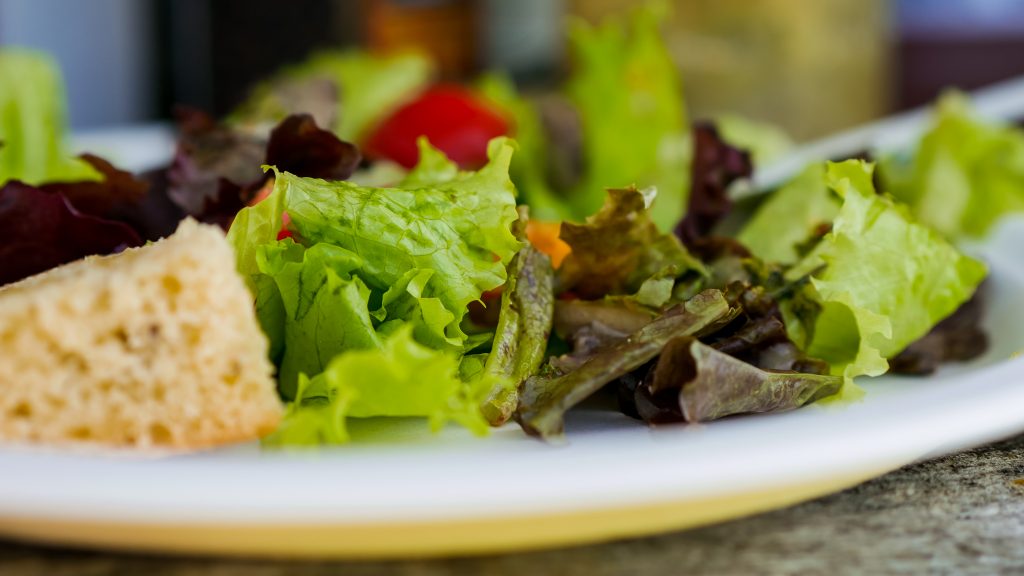
Detox The Liver
The liver removes many of the body’s major toxins and affects allergies. Martin Healy says that key ways to boost your liver function include cutting out alcohol, smoking, caffeine and embarking on a detox program.
A glass of water containing freshly squeezed lemon each morning will help. Antioxidants and vitamins found in fresh fruits and vegetables will reduce liver inflammation and boost immune function, while foods like brussels sprouts will increase the activity of important liver enzymes.
Herbs and Nutritional Supplements for Seasonal Allergies
These herbs and nutritional supplements are best taken on a daily basis. Taking them before allergy season even starts, can prevent symptoms altogether. They can also be used as needed.
- Stinging Nettle: Nettles are used as spring tonics and a general detoxifying remedy. In some cases of rheumatism and arthritis, nettles can be astoundingly successful. In childhood eczema nettles are a specific remedy and are beneficial in all the varieties of this condition especially in nervous eczema.
Nettles in high doses can have amazing results for allergy sufferers. It has been used for centuries to treat allergy symptoms – particularly hay fever – which is the most common allergy problem. It contains biologically active compounds that reduce inflammation. Dr. Andrew Wiel M.D. author of Natural Health/Natural Medicine says he knows of nothing more effective than nettle for allergy relief. This statement is backed up by studies at the National College of Naturopathic Medicine in Portland, Oregon. Decongestants, antihistamines, allergy shots and even prescription medications such as Allegra and Claritin treat only the symptoms of allergies and tend to lose effectiveness over a period of time. They can also cause drowsiness, dry sinuses, insomnia and high blood pressure. Nettle has none of these side effects. It can be used on a regular basis and has an impressive number of other benefits most notably as a treatment for prostate enlargement. Nettle is easily available in tea and tincture form, and also can be eaten like spinach in the spring, made into soups and smoothies. Nettles are prized for being highly nutritional.
- Raw Local Honey: Raw honey is great, but raw local honey is even better! Raw local honey contains pollen that is specific to your area and therefore can really help those local seasonal allergies. Taking a spoonful of raw honey once or twice a day is a great help. It is also advised to begin taking local honey a few months prior to the allergy season; this gets the pollen introduced into the body and gradually builds up the body’s tolerance to seasonal allergies. Honey is not recommended for babies under 12 months, due to infant botulism.
- Vitamin C: To assist with a malfunctioning immune system try lemon water and orange water (not juice – no sugar), cultured vegetables and strawberries.
- Quercetin: 500 mg daily (half that for kids). Quercetin is a plant pigment found in many common herbs and foods, and a very reliable anti-inflammatory nutritional supplement. It helps with gut repair, boosts the immunity in your mucus membranes reducing reactivity to seasonal allergens, and also helps reduce food allergies. There is conflicting data on whether it is safe in pregnancy, therefore I would not recommend it for those who are pregnant.
- Zinc: Take an age appropriate dose daily.
- Please visit your doctor when necessary!
Traditional Allergy Tincture Blend
- Nettle (Urtica dioica, spring tops) 0.30 ml
- Astragalus (Astragalus membranaceus, root) 0.25 ml
- Reishi (Ganoderma lucidum, thallus) 0.14 ml
- Schisandra (Schisandra chinensis, fruit) 0.14 ml
- Southern Prickly Ash (Zanthoxylum clava-herculis, bark) 0.07 ml
Keep an eye out for another blog full of Stinging Nettle Recipes soon!

